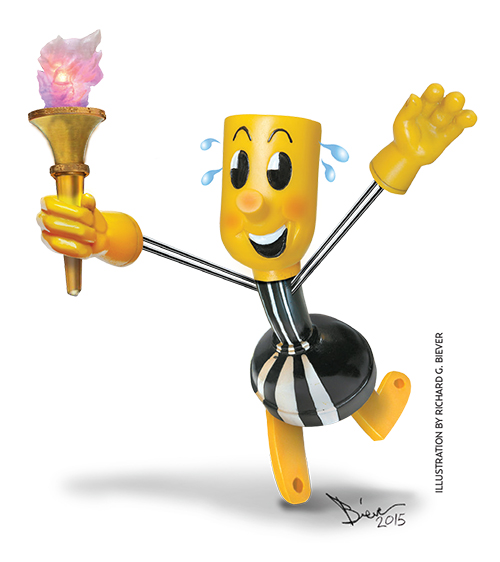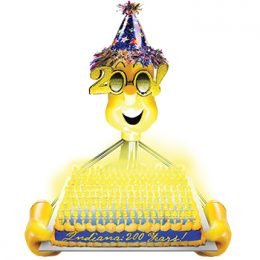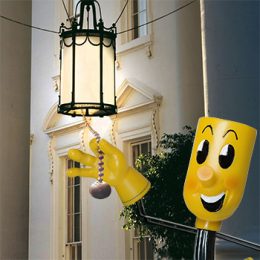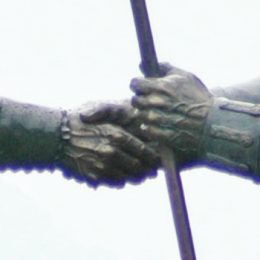 Each month throughout 2016, electric cooperative mascot Willie Wiredhand will shine a little light on Hoosier history. Willie says let’s get the 2016 big bicentennial birthday bash off and running with some basic facts and figures … and fun bits of Hoosier trivia!
Each month throughout 2016, electric cooperative mascot Willie Wiredhand will shine a little light on Hoosier history. Willie says let’s get the 2016 big bicentennial birthday bash off and running with some basic facts and figures … and fun bits of Hoosier trivia!
-

Though Willie has a few years behind him, he says he prefers the LED version of the torch for the torch relay, as opposed to the one with the open flame.
Indiana was officially admitted to the United States on Dec. 11, 1816. It is the 19th state.
- After the original 13 colonies, only five other states preceded Indiana into the Union. They are Vermont (in 1791); Kentucky (1792); Tennessee (1796); Ohio (1803); and Louisiana (1812).
- “Indiana” means “Land of the Indians.”
- 6.6 million people called Indiana home in 2014, making it the 16th most populous state.
- At 36,418 square miles, Indiana ranks 38th among the 50 states in area. Indiana is the smallest state west of the Appalachian Mountains (excluding Hawaii).
- The state has a maximum dimension north to south of 250 miles, and a maximum east to west dimension of 145 miles.
- While the Ohio River plays a larger role in Indiana history and its economy and forms the state’s entire southern border, the Wabash River is the official state river. The Wabash flows almost entirely within the state.
- “On the Banks of the Wabash, Far Away” was written by Terre Haute native Paul Dresser in 1897 and adopted as the state song in 1913. The song is easily confused with “Back Home Again in Indiana” — a 1917 song that borrows heavily musically and lyrically from Dresser’s song. “Back Home Again in Indiana” is the one traditionally sung before each Indianapolis 500 race in May.
- The state flag was designed by Paul Hadley of Mooresville as part of Indiana’s centennial celebration flag design contest and adopted in 1917. The flag has a blue background with yellow-gold symbols. The torch in the middle of the flag represents liberty and enlightenment. The rays illustrate their far-reaching influence. There are 19 stars on the flag. The outer circle represents the original 13 states. The stars in the semi-circle stand for the five states admitted to the Union before Indiana. The star directly above the torch symbolizes Indiana.
- Holy flag-rant rip-off: The design of the Indiana flag was used for the Gotham City flag in the 1989 “Batman” movie.
- A torch relay to celebrate the bicentennial will begin in Corydon, the state’s first capital, Sept. 9, pass through all 92 counties, and end at the Statehouse in Indianapolis, Oct. 15. The relay torch was designed and built by Purdue University engineering students to replicate the torch on the state flag. The torch will burn E85, a blended ethanol-based fuel partly made of Indiana corn. (A smaller, “kid-friendly” torch was also built for younger Hoosier torchbearers. It uses cool, energy-efficient LED lights instead of a flame.) To nominate a local torchbearer for the relay, go to indiana2016.org/torchrelay.
Stay tuned each month as Willie presents more Indiana “Bicentennial Zingers.”



